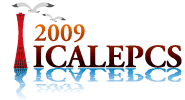ICALEPCS 2009
MOB005
SLIDE
The CMS Detector Control System
A.Racz, B.Beccati, C.Deldicque, C.Schwick, D.Gigi, E.Cano, E.Meschi, F.Glege, F.Meijers, H.Sakulin, J.A.Coarasa, J.F.Laurens, J.Gutleber, L.Orsini, M.Ciganek, M.Simon, M.Zanetti, R.Gomez-Reino*, R.Moser, S.Cittolin, Y.L.Hwong (CERN) A.Meyer, D.Hatton, U.Behrens (DESY) D.Shpakov, H.Cheung, J.A.Lopez-Perez, K.Biery, R.K.Mommsen, V.O'Dell (Fermilab) A.S.Yoon, C.Loizides, C.Paus, F.Ma, G.Bauer, J.F.Serrano Margaleff, K.Sumorok (MIT) S.Erhan (UCLA) A.Petrucci, J.Branson, M.Pieri, M.Sani (UCSD)
The Compact Muon Solenoid (CMS) experiment at CERN is one of the Large Hadron Collider multi-purpose experiments. Its large subsystems size sum up to around 6 million Detector Control System (DCS) channels to be supervised. A cluster of ~100 servers is needed to provide the required processing resources. To cope with such a size a scalable approach has been chosen factorizing the DCS system as much as possible. CMS DCS has made a clear division between its computing resources and functionality by creating a computing framework allowing for plugging in functional components. DCS components are developed by the subsystems expert groups while the computing infrastructure is developed centrally. To ease the component development task, a framework based on PVSSII [1] has been developed by the CERN Joint Controls Project [2] (JCOP). This paper describes the current status of CMS Detector Control System, giving an overview of the DCS computing infrastructure, the integration of DCS subsystem functional components and the experience gathered so far.

